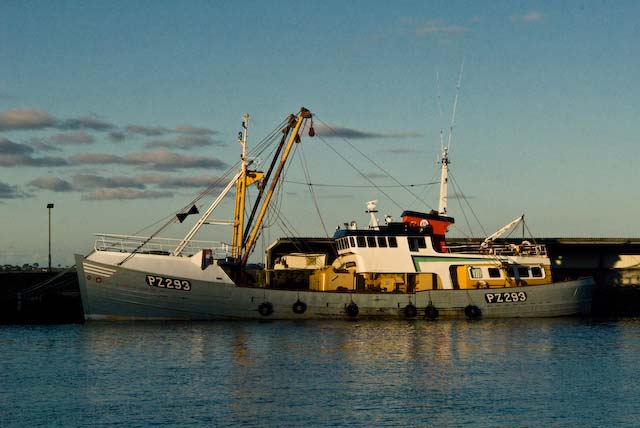 |
| Marie Claire built 1945 by Rowhedge Ironworks and converted to beam trawling in 1988. |
Despite the port being home to Stevensons, the largest fleet of privately owned trawlers and beam trawlers in Europe not one new beam trawler was ordered. The firm expanded rapidly in size in the 70s and 80s with ex-Dutch beam trawlers along with four ex-Sputniks trawlers from Scotland and even re-commissioned some of its ex-Admiralty wooden trawlers built in the 1940s and converted them to beam trawling. Though if you ever asked the firm's patriarch Billy Stevenson why he would reply, "See, new boats don't catch any more fish".
There's no doubt that for the last 20 years the average age of boats brought to the port has significantly decreased as private individuals and company owners have seen fit to invest heavily in modernising the fleet. New builds ordered to fish from Newlyn have all been 15m or under; the Rowse family have had three crabbers built, Stefan Glinski, Sam Lambourn and Ocean Fish have all had various sardine ring netters built to order, all also under 15m.
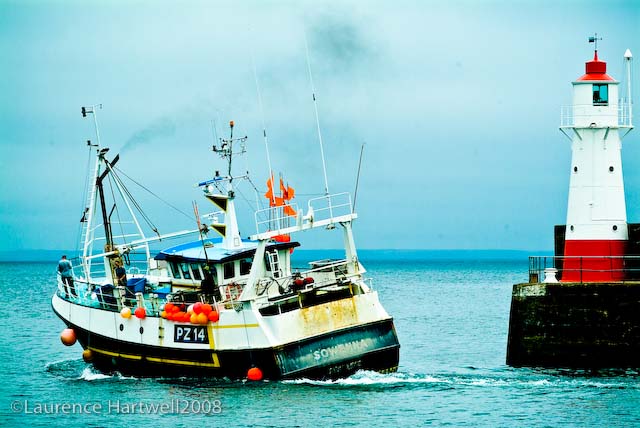
Before that you have to go back to 31 years to 1989 when Ian Mitchell, with much foresight, had the GRP Sowenna built to fish the then fast developing hake gill-net fishery - she was also another (under the skipper's ticket size) 15m vessel. You have to go back all the way to 1981...
when the Thomas family had the Girl Pat III PZ87 built at McTays - a 23m steel multi-purpose trawler complete with RSW tanks - over her career in Newlyn she successfully long-lined, bottom, mid-water and beam trawled. Before that it was down to Porthleven skipper Michael Hosking to have the 26m Sputnik class trawler Dew-Genen-Ny built in 1976 which began life as a long-liner/trawler then later to become a hugely successful seine netter under skipper Robert George...
Prior to that you have to go back yet another decade to 1969 when the Stevens family from St Ives had their second Rose of Sharon FR23 built by Forbes of Sandhaven -
But that is when our story really starts - just before WWI the Stevens family moved from St Ives to Darwin in Lancashire. The patriarch of the family at the time, John Stevens had 8 children, 5 boys 3 girls.
John the eldest son was in Nova Scotia when his father also John was in Darwin they were in touch by cable and letter. John came back to meet his family in St Ives they bought a boat and named her Amelia named after mother and their daughter. Ernie and family who were up in Darwin came back with his dad and met his older brother John in St Ives.
The Amelia was lost in the 1930s with two Stevens brothers, Freddy and Barnie. Another brother, Bill survived. At that time Ernie Stevens (David's great grandfather) was working his own boat, thought to be the Dorothy.
For the Stevens family their story goes back several generations to 1937 and a 26' St Ives boat called the Boy Ernest SS2 was built for Ernest Stevens by Tommy Thomas as a replacement for the family boat Dorothy SS66 built in 1906. These boats fished according to the seasons mainly for mackerel, herring, ray and skate using lines and nets. Eventually, fishing opportunities changed and some of the fishing family moved away to Yorkshire to work in the mills.
One Stevens had emigrated to Canada but kept in touch with news from St Ives and heard that fishing was on the up - he returned home and the next chapter of the family's fishing story opened up after the end of WWII - with a boat called the Sweet Promise, also built by Tommy Thomas in 1947...
and built by Percy Mitchel in Portmellion near Mevagissey in 1952 for great grandfather Ernie and son Ernie and John Woolcott Stevens another brother joined them in 1958. - she was 50’ in length and built with a Kelvin 88hp main engine and a 44hp wing engine. Great-grandfather, grandfather (Boy Ernie) and great Uncle John (John 'Woolie') worked the vessel together. They fished for pelagic fish (sardines, herring and mackerel) using drift nets, ring net, and purse net, in the winter of 1956-57. They were one of the first vessels in the UK to adopt the purse seine net method of fishing when they fished for herring in Dunmore, Ireland. ....
in the summer months they would shoot longlines for rays, skates and other fishes...
fishing for herring out of Dunmore for many years...
then in 1964 came Rose of Sharon, with the first SS118 registration and built in 1964 by Ernie Stevens for long-lining...
in 1967 the world's first serious ecological disaster occurred off Lands End when the oil tanker Torrey Canyon ran across the Sevenstones reef...
following the disaster local fishing boats, including the Rose of Sharon, were commissioned to carry barrels of detergent aboard to fight the subsequent huge oil slick at sea...
and spray the contaminated cliffs from St Ives right round Lands End to Porthcurno...
two years later and and the Stevens family steamed the next Rose of Sharon for home, again built by the Forbes boatyard in Sandhaven...
from left to right, Francis Stevens, Matthew Perkin Mathis, David Stevens Snr, grandfather Ernest Stevens, Raymond Stevens, Morris Golding, and Paul Stevens...
another family at work pic pic, Davis Stevens Snr aged 19 hauling the great lines alongside his father Ernest Stevens, you can see the rays laid out on the deck, this picture was kindly given to us by Peter Pollard...
in those days, grandfather (to skipper David Stevens) Ernest Stevens had his 8mm cine film to hand to record the Rose of Sharon while she was still on the stocks at Forbes' yard, then the launch and trip down through the Caledonian canal before they arrived in St Ives Bay in front of an admiring local crowd.
David Stevens, current skipper of the Crystal Sea continues the story:
"This vessel had to be registered in Fraserburgh FR 23 as she was longer than the previous boat being 65’ in length. My grandfathers skipper’s ticket only went up to vessels of 50 metric tonnes. In Scotland for some reason they registered lighter than in England, so to get her under 50 tonnes registered, he opted for a Scottish registry. She was built with a 320hp Kelvin and was rigged for longlining and trawling...
My dad worked the second Rose of Sharon with his brothers in 1970 after my Grandfather became ill. They did a couple of lining seasons but trawling became a more profitable way of fishing for us. They pair trawled in the winter for mackerel and sardines very successfully. In the summer they trawled for mixed whitefish. In the early 1980’s they started using hopper trawls which meant they could work grounds that used to be inaccessible...
Throughout the 80s in Newlyn there was a fleet of 50-60' trawlers known 'The Clan' - it was even painted on the quay apron to mark the berth they used.
In the late 1980’s my dad decided to get another vessel to work alongside his brother who was now working the Rose Of Sharon. In 1989 we went up to Macduff in Scotland and bought the first Crystal Sea...
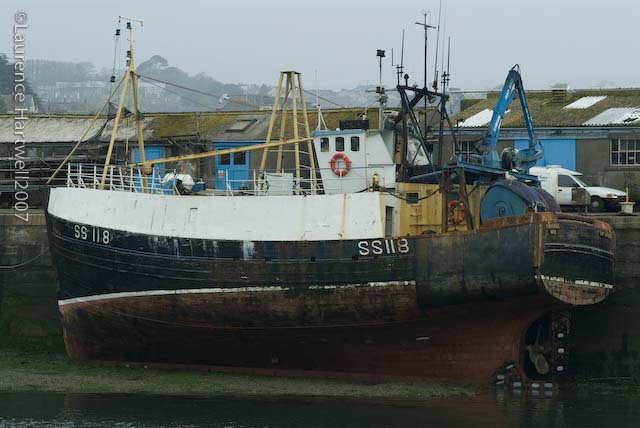
We registered her to St.Ives with the number SS 118. She was rigged for stern trawling and white fish pair trawling. She was built by Macduff Shipyards in 1974 and was fitted with a shelter deck, a double net drum, 12ton trawl winch and power block. There was a 535hp Kelvin main engine and a 4-1 reduction Reintjes gear box and a 22hp Lister auxiliary engine...
In 1990 I joined my dad on this boat followed by my brother Alec in 1992. We fished this vessel together for 18 years. Fishing went through some hard times in the late 1990’s but by the early 2000’s the fishing had turned the corner and we modernised this vessel extensively. By 2007 we were ready to step up to a newer vessel...
In October of 2007 we went up once again to Scotland and we purchased the Crystal Sea II. She was another big step up and this was a purpose built stern trawler which was fully sheltered just open aft on the stern...
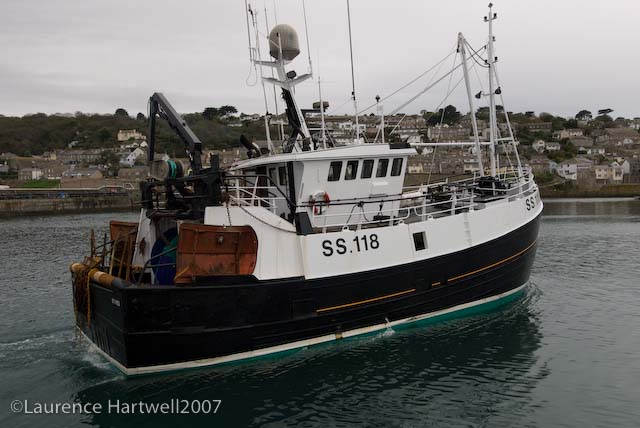
She was built in 1989 by Macduff shipyards with a 650hp Caterpillar engine, a 250hp Deutz auxiliary hydraulic engine, 3 barrelled winch and two double net drums. She also had a 1.8 metre propeller in a nozzle, which gave us far greater towing ability and crucially she was set up to twin rig trawl which is the method my brother and I have adopted successfully on our grounds...

The Crystal Sea II was a great boat for our family. We learnt many new techniques and she has took us further than we ever thought possible. We now land our catches to PTA, which has really benefited our business by use of the internet auction - opening new markets and maintaining and delivering a high quality product to our customers...
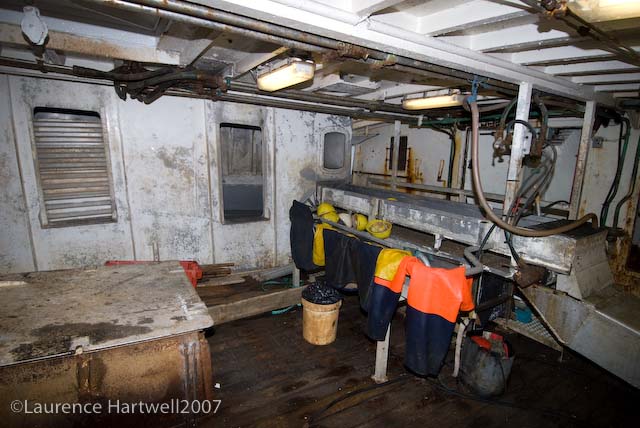
As in all industries, over the generations the modern methods of going about our work have improved the efficiency of our operation and quality of our fish. We now have conveyors, fish washers and modern fish rooms which are fully insulated and temperature controlled. The story doesn’t end there...

In April 2016 we purchased a replacement for the Crystal Sea II. The Crystal Sea III was a 21 metre steel vessel built at Macduff shipyards in 2009. This vessel was a purpose built trawler with a hull designed to achieve maximum efficiency whilst towing and optimum fuel consumption. She was fitted with the most up to date fish handling systems with conveyors from the hopper through to the twin washing system then down to the fish room.
Once in the fully insulated temperature controlled fish room the fish is weighed and packed into 30-35 kg boxes, the vessel has her own ice machine so the fish is kept in optimum condition. We worked 5-6 day trips to maximise the freshness and quality of our fish.
The vessel is great to work with, she has the most up to date equipment throughout the boat and added extras for the crew comfort like WiFi, washing and drying machines and very quiet cabins! She is fully air conditioned, she also has a full length shelter deck so all operations are under cover, just to make the hard life we have at sea a little more bearable."
Before moving on to the next chapter in the Stevens fishing family history
While fishing with the new Crystal Sea David along with his father and brother Alec became increasingly interested in developing the means to minimise discards as quotas tightened - especially for one species in particular, haddock. Although well supported by Cefas and Defra on some projects, much of their pioneering work and willingness to accommodate controversial technical measures like installing video surveillance recording system has been funded straight from the cod end...
The Crystal Sea was one of the first Cornish boats working with Seafood Cornwall to promote quality Cornish trawl fish...
Over the years the boat has also played host to creative arts students willing to subject themselves to a week at sea in order to try and capture something of the unique way of life that is fishing - one such venture was Shore to Sea...
In 2018 the family decided - despite the uncertainty posed by the chaotic Brexit negotiations - to invest in a new build - and the idea of a third Crystal Sea was born. She was to take advantage of the latest in gear, propulsion, fishing and fish finding technology - much of it enabled through 8 powerful PCs in the wheelhouse. The 24m twin-rig stern trawler was to be built by the legendary Macduff shipyard in Scotland incorporating the very latest in hull and deck layout design and build techniques.
Through the Gaps wishes Crystal Sea all the best for the future.
CRYSTAL SEA SS 118
DETAILS Owners: Crystal Sea Fishing Ltd St Ives Cornwall
There's no doubt that for the last 20 years the average age of boats brought to the port has significantly decreased as private individuals and company owners have seen fit to invest heavily in modernising the fleet. New builds ordered to fish from Newlyn have all been 15m or under; the Rowse family have had three crabbers built, Stefan Glinski, Sam Lambourn and Ocean Fish have all had various sardine ring netters built to order, all also under 15m.

Before that you have to go back to 31 years to 1989 when Ian Mitchell, with much foresight, had the GRP Sowenna built to fish the then fast developing hake gill-net fishery - she was also another (under the skipper's ticket size) 15m vessel. You have to go back all the way to 1981...
when the Thomas family had the Girl Pat III PZ87 built at McTays - a 23m steel multi-purpose trawler complete with RSW tanks - over her career in Newlyn she successfully long-lined, bottom, mid-water and beam trawled. Before that it was down to Porthleven skipper Michael Hosking to have the 26m Sputnik class trawler Dew-Genen-Ny built in 1976 which began life as a long-liner/trawler then later to become a hugely successful seine netter under skipper Robert George...
Prior to that you have to go back yet another decade to 1969 when the Stevens family from St Ives had their second Rose of Sharon FR23 built by Forbes of Sandhaven -
But that is when our story really starts - just before WWI the Stevens family moved from St Ives to Darwin in Lancashire. The patriarch of the family at the time, John Stevens had 8 children, 5 boys 3 girls.
John the eldest son was in Nova Scotia when his father also John was in Darwin they were in touch by cable and letter. John came back to meet his family in St Ives they bought a boat and named her Amelia named after mother and their daughter. Ernie and family who were up in Darwin came back with his dad and met his older brother John in St Ives.
The Amelia was lost in the 1930s with two Stevens brothers, Freddy and Barnie. Another brother, Bill survived. At that time Ernie Stevens (David's great grandfather) was working his own boat, thought to be the Dorothy.
For the Stevens family their story goes back several generations to 1937 and a 26' St Ives boat called the Boy Ernest SS2 was built for Ernest Stevens by Tommy Thomas as a replacement for the family boat Dorothy SS66 built in 1906. These boats fished according to the seasons mainly for mackerel, herring, ray and skate using lines and nets. Eventually, fishing opportunities changed and some of the fishing family moved away to Yorkshire to work in the mills.
 |
| Sweet Promise built 1947 |
she was swiftly followed by a new Sweet Promise designed...
and built by Percy Mitchel in Portmellion near Mevagissey in 1952 for great grandfather Ernie and son Ernie and John Woolcott Stevens another brother joined them in 1958. - she was 50’ in length and built with a Kelvin 88hp main engine and a 44hp wing engine. Great-grandfather, grandfather (Boy Ernie) and great Uncle John (John 'Woolie') worked the vessel together. They fished for pelagic fish (sardines, herring and mackerel) using drift nets, ring net, and purse net, in the winter of 1956-57. They were one of the first vessels in the UK to adopt the purse seine net method of fishing when they fished for herring in Dunmore, Ireland. ....
in the summer months they would shoot longlines for rays, skates and other fishes...
fishing for herring out of Dunmore for many years...
then in 1964 came Rose of Sharon, with the first SS118 registration and built in 1964 by Ernie Stevens for long-lining...
in 1967 the world's first serious ecological disaster occurred off Lands End when the oil tanker Torrey Canyon ran across the Sevenstones reef...
following the disaster local fishing boats, including the Rose of Sharon, were commissioned to carry barrels of detergent aboard to fight the subsequent huge oil slick at sea...
and spray the contaminated cliffs from St Ives right round Lands End to Porthcurno...
two years later and and the Stevens family steamed the next Rose of Sharon for home, again built by the Forbes boatyard in Sandhaven...
from left to right, Francis Stevens, Matthew Perkin Mathis, David Stevens Snr, grandfather Ernest Stevens, Raymond Stevens, Morris Golding, and Paul Stevens...
another family at work pic pic, Davis Stevens Snr aged 19 hauling the great lines alongside his father Ernest Stevens, you can see the rays laid out on the deck, this picture was kindly given to us by Peter Pollard...
David Stevens, current skipper of the Crystal Sea continues the story:
"This vessel had to be registered in Fraserburgh FR 23 as she was longer than the previous boat being 65’ in length. My grandfathers skipper’s ticket only went up to vessels of 50 metric tonnes. In Scotland for some reason they registered lighter than in England, so to get her under 50 tonnes registered, he opted for a Scottish registry. She was built with a 320hp Kelvin and was rigged for longlining and trawling...
My dad worked the second Rose of Sharon with his brothers in 1970 after my Grandfather became ill. They did a couple of lining seasons but trawling became a more profitable way of fishing for us. They pair trawled in the winter for mackerel and sardines very successfully. In the summer they trawled for mixed whitefish. In the early 1980’s they started using hopper trawls which meant they could work grounds that used to be inaccessible...
 |
| L - R: Ben-my-Chree, Girl Patricia, Rose of Sharon, Keriolet, Wyre Star, Galilean was at sea. |
In the late 1980’s my dad decided to get another vessel to work alongside his brother who was now working the Rose Of Sharon. In 1989 we went up to Macduff in Scotland and bought the first Crystal Sea...

In 1990 I joined my dad on this boat followed by my brother Alec in 1992. We fished this vessel together for 18 years. Fishing went through some hard times in the late 1990’s but by the early 2000’s the fishing had turned the corner and we modernised this vessel extensively. By 2007 we were ready to step up to a newer vessel...
In October of 2007 we went up once again to Scotland and we purchased the Crystal Sea II. She was another big step up and this was a purpose built stern trawler which was fully sheltered just open aft on the stern...

She was built in 1989 by Macduff shipyards with a 650hp Caterpillar engine, a 250hp Deutz auxiliary hydraulic engine, 3 barrelled winch and two double net drums. She also had a 1.8 metre propeller in a nozzle, which gave us far greater towing ability and crucially she was set up to twin rig trawl which is the method my brother and I have adopted successfully on our grounds...

The Crystal Sea II was a great boat for our family. We learnt many new techniques and she has took us further than we ever thought possible. We now land our catches to PTA, which has really benefited our business by use of the internet auction - opening new markets and maintaining and delivering a high quality product to our customers...

As in all industries, over the generations the modern methods of going about our work have improved the efficiency of our operation and quality of our fish. We now have conveyors, fish washers and modern fish rooms which are fully insulated and temperature controlled. The story doesn’t end there...

In April 2016 we purchased a replacement for the Crystal Sea II. The Crystal Sea III was a 21 metre steel vessel built at Macduff shipyards in 2009. This vessel was a purpose built trawler with a hull designed to achieve maximum efficiency whilst towing and optimum fuel consumption. She was fitted with the most up to date fish handling systems with conveyors from the hopper through to the twin washing system then down to the fish room.
Once in the fully insulated temperature controlled fish room the fish is weighed and packed into 30-35 kg boxes, the vessel has her own ice machine so the fish is kept in optimum condition. We worked 5-6 day trips to maximise the freshness and quality of our fish.
The vessel is great to work with, she has the most up to date equipment throughout the boat and added extras for the crew comfort like WiFi, washing and drying machines and very quiet cabins! She is fully air conditioned, she also has a full length shelter deck so all operations are under cover, just to make the hard life we have at sea a little more bearable."
Before moving on to the next chapter in the Stevens fishing family history
While fishing with the new Crystal Sea David along with his father and brother Alec became increasingly interested in developing the means to minimise discards as quotas tightened - especially for one species in particular, haddock. Although well supported by Cefas and Defra on some projects, much of their pioneering work and willingness to accommodate controversial technical measures like installing video surveillance recording system has been funded straight from the cod end...
The Crystal Sea was one of the first Cornish boats working with Seafood Cornwall to promote quality Cornish trawl fish...
"Tread a week in the boots of the fishermen trawling the Cornish coast director Matthew Newton talks about Hunters, a film he co-directed alongside filmmakers Matteo Born and Mateo Ybarra about fishermen working off the coast of Newlyn, Cornwall:
"Inspired by stories of a way of life carried down through the generations, Hunters is a film that observes one of the oldest professions—hunting at sea.
“Through relentless swell of the ocean and the constant growl of their engine we wanted to give a sense of the trawlers' reality”
“Spending a week aboard Cornish trawler The Crystal Sea with a varied crew, from fresh to seasoned deckhands, we were able to capture the difficulty of the environment while giving a sense of the claustrophobia of the trawlers’ working lives.
“Through the relentless swell of the ocean and the constant growl of the boat's engine, the sound of chains clattering while releasing or hauling in nets, we wanted to give a sense of the trawlers' reality, emphasizing the impossibility of escape once there."
In 2018 the family decided - despite the uncertainty posed by the chaotic Brexit negotiations - to invest in a new build - and the idea of a third Crystal Sea was born. She was to take advantage of the latest in gear, propulsion, fishing and fish finding technology - much of it enabled through 8 powerful PCs in the wheelhouse. The 24m twin-rig stern trawler was to be built by the legendary Macduff shipyard in Scotland incorporating the very latest in hull and deck layout design and build techniques.
Through the Gaps wishes Crystal Sea all the best for the future.
There will be a review of Crystal Sea's fishing and fishfinding gear to follow in the near future. In the meantime here is a comprehensive look at the build:
CRYSTAL SEA SS 118
DETAILS Owners: Crystal Sea Fishing Ltd St Ives Cornwall
Designer/Boatyard: Macduff Shipyards Ltd yard number 686
Agent: Plymouth Trawler Agents
DIMENSIONS and CAPACITIES
Length overall: 24.50m; Length reg: 22.78m; Beam: 7.6m; Depth moulded: 4.3 m; Draft: 4.8m; Tonnage: 273 tonnes gross; Fuel: 21,028 litres; Fresh water: 25,425 litres; Lube oil: 500 litres; Hydraulic oil: 1860 litres; Fishroom: 700 boxes; 8tons of ice.
ENGINEROOM
Main engine: Caterpillar C32 of 492kW @ 1800 rpm driving through a Masson Marine 9:1 reduction gearbox to a 2500 mm diameter four bladed propeller. Speed: 10.4 knots
Auxiliary engines: Caterpillar C12 variable speed engine of 286kW @ 1800 rpm driving deck machinery hydraulic pumps via a Centra Drive; 2 x Beta Marine generators based on Cummins 6BT5.9D2(M) engines of 86kW @ 1500rpm driving 81.6kW 415/3/50 Mecc Alte alternators
Bow thruster: Hardy Engineering T700 112kW
Fuel/oil filters/separators: CC Jensen
Bilge/deckwash and deck sump pumps: 4 x Bombas Azcue SA electrically driven
DECK MACHINERY
Suppliers: Macduff Shipyards Ltd & Macgregor Ltd, Peterhead
3 x Macduff 2speed split trawl winches ; 2 x Macduff split net drums 2 x 10t; 4 x Macduff 2speed split sweep winches ; Macgregor Gilson winch 5t; 2 x Macduff gear handling winches 4.5t; 1 x Anchor Windlass; Macgregor RPBC 14 kinked boom short post crane SWL 1700kg - 6.5m and 24in tilting ribbed head powerblock; Macgregor RLC 8 1000kg - 8m straight boom landing crane c/w landing winch
FISH HANDLING/FISHROOM
Fish handling system: Macduff Shipyards Ltd; Fishroom chilling: Premier Refrigeration Ltd., Fraserburgh; Ice Machine: Geneglace 2.5t/day Premier Refrigeration Ltd.
Suppliers: Woodsons mostly, Wassp Furuno, Sodena, Selex
Fish detection
JRC JFC 180 BB (38khz) echo sounder; WASSP F3i (160kHz) multi-beam sounder; Simrad PX twin rig Geometry net monitoring system c/w with door angle type of sensors
NAVIGATION
JRC JMA 53126 BB and JRC JMA-3334 radars; 2 x Furuno GP-39 GPS receivers; Olex 3D dual screen seabed mapping system; MaxSea TimeZero and Sodena Easywin plotting systems; Navitron NT921 MKII autopilot; JLC JLR 21 satellite compass; JLN 741N Doppler speed log; Gill ultrasonic wind speed and direction sensor
COMMUNICATIONS
JRC-JSS-2150 150W GMDSS MF/HF SSB radio telephone; 2 x Icom M506E DSC VHFs; Entel HT649 GMDSS Hand Held VHF; Jotron TR-8000 Class A AIS; Phontech 5 way system talkback; JRC Navtex; Jotron TRON 60GPS EPIRB; eSEA 60 Internet communications system; LT-3100 Iridium communications system; eSEA 60 Satellite TV system; VCU Catch Management electronic fishroom scales; E Catch Log book software; Woodsons CCTV system c/w 17 ( 1 prop cam) cameras; 8 x 8way HDMI matrix c/w iPad control.
FISHING GEAR
Net Suppliers: Faithlie Trawls, Fraserburgh - 2 x 190 groundfish fish scraper nets rigged on 150 of 8in & 10in discs: 2 x 171 ground fish scapper rigged on 125feet 8 and 10 inch discs Warp supplier: marine co_2 x 275 fathoms of 22mm diameter fibre core wire: 1 x 275 fathom 24mm warp middle Sweeps: Marine Co 80 fathom 42mm combination: Doors: Thyboron type 22vf trawl doors 3m2/ 840kg; Middle roller: Macduff Shipyards 1150kg
ACCOMMODATION
1x berth skippers 1x2 berth single cabin 1x3 berth cabin 1x2 berth cabin
8 berth total All 3 ft single mattress.
GENERAL
Engine controls: Kobelt electronic 3-station; Insurance: Sunderland Marine; Lifesaving appliances: flares and life belts etc blue anchor/ PFD with PLB x 8 plus survival suits Newline chandlery; Paint: International Paints; Steering: Scan Steering Aps; Wheelhouse seats: 2 x NorSap; Wheelhouse windows: HK Van Wingerden & Zn BV, Holland
Fuel suppliers: Smithy in Scotland, Consol Oils whilst working from Newlyn
Fish transportation: Cornwall Transport
Gear transhipped to Scotland by Dennis Oates and Sons
Landing agent fish sold through PTA Plymouth Trawler Agents
Insurance through Sunderland Marine.















